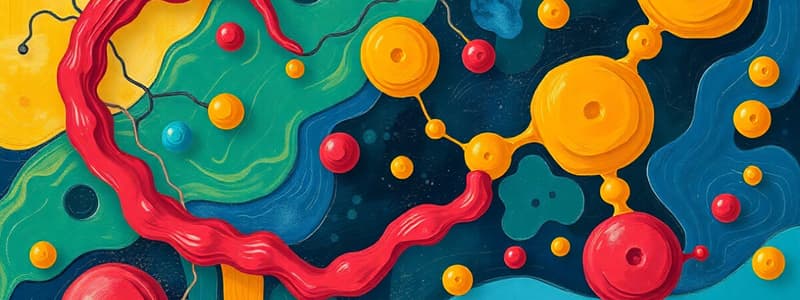Podcast
Questions and Answers
What are the products of pyruvate oxidation?
What are the products of pyruvate oxidation?
The citric acid cycle directly consumes oxygen.
The citric acid cycle directly consumes oxygen.
False
What is the role of amylases in carbohydrate digestion?
What is the role of amylases in carbohydrate digestion?
Where does gluconeogenesis primarily occur?
Where does gluconeogenesis primarily occur?
Signup and view all the answers
The major substrates for gluconeogenesis include lactate, pyruvate, and ________ acids.
The major substrates for gluconeogenesis include lactate, pyruvate, and ________ acids.
Signup and view all the answers
Gluconeogenesis is involved in the catabolism of carbohydrates.
Gluconeogenesis is involved in the catabolism of carbohydrates.
Signup and view all the answers
Match the following enzyme processes with their main effects:
Match the following enzyme processes with their main effects:
Signup and view all the answers
Name the process by which glucose is converted into acetyl CoA.
Name the process by which glucose is converted into acetyl CoA.
Signup and view all the answers
The primary energy source for most body tissues is ____.
The primary energy source for most body tissues is ____.
Signup and view all the answers
What happens to NADH and FADH2 produced during the citric acid cycle?
What happens to NADH and FADH2 produced during the citric acid cycle?
Signup and view all the answers
The citric acid cycle turns twice for every starting glucose.
The citric acid cycle turns twice for every starting glucose.
Signup and view all the answers
Match the biochemical processes with their corresponding type:
Match the biochemical processes with their corresponding type:
Signup and view all the answers
What compound does acetyl CoA combine with to initiate the citric acid cycle?
What compound does acetyl CoA combine with to initiate the citric acid cycle?
Signup and view all the answers
What products are generated from one molecule of glucose during glycolysis?
What products are generated from one molecule of glucose during glycolysis?
Signup and view all the answers
Glycogen is stored primarily in the liver after glucose absorption.
Glycogen is stored primarily in the liver after glucose absorption.
Signup and view all the answers
What are the two types of enzymes important for carbohydrate digestion?
What are the two types of enzymes important for carbohydrate digestion?
Signup and view all the answers
Study Notes
Carbohydrates
- Carbohydrates are a significant class of biomolecules
- They are condensation products of more than 10 monosaccharide units
- These units can link linearly (α(1-4) linkage) or branched (α(1-6) linkage)
- Common examples include starch, glycogen, cellulose, dextran, inulin and chitin.
Digestion of Carbohydrates
- Digestion relies on two types of enzymes:
- Amylases break down polysaccharides into disaccharides
- Disaccharidases break down disaccharides into monosaccharides
- Examples of disaccharidases include:
- Maltase breaks down maltose
- Sucrase breaks down sucrose
- Lactase breaks down lactose
Carbohydrate Metabolism
- Carbohydrate catabolism involves:
- Glycolysis
- Krebs cycle
- Pentose phosphate pathway
- Glycogenolysis
- Carbohydrate anabolism includes:
- Gluconeogenesis
- Glycogenesis
Glycolysis
- Glycolysis is the breakdown of glucose in the cytoplasm of all cells in the body
- It may be aerobic (in the presence of oxygen) or anaerobic (in the absence of oxygen)
- Aerobic glycolysis produces 2 pyruvate and 8 ATP
- Anaerobic glycolysis produces 2 lactate and 2 ATP
- It may be aerobic (in the presence of oxygen) or anaerobic (in the absence of oxygen)
- Location: Cytosol
- Substrate: Glucose (C6H12O6)
- Products: 2 pyruvate, 2 ATP, 2 NADH
Pyruvate Oxidation
- Location: Mitochondrial matrix
- Substrate: 2 pyruvate
- Products: 2 acetyl CoA, 2 NADH, 2 CO2
Krebs Cycle
- Also known as the citric acid cycle or tricarboxylic acid cycle
- It takes place in the mitochondrial matrix
- It occurs after pyruvate oxidation
- It involves the oxidation of acetyl-CoA to generate ATP, NADH, and FADH2
- Products
- 2 ATP, 6 NADH, 2 FADH2, 4 CO2
Gluconeogenesis
- It is the formation of glucose from non-carbohydrate sources
- The major substrates include lactate, pyruvate, glucogenic amino acids, propionate and glycerol.
- Location: Mainly in the liver, and to a lesser extent in the renal cortex.
- The pathway is partly mitochondrial and partly cytoplasmic.
- The synthesis of glucose from non-carbohydrate compounds is known as gluconeogenesis.
Studying That Suits You
Use AI to generate personalized quizzes and flashcards to suit your learning preferences.
Related Documents
Description
This quiz covers the fundamental concepts of carbohydrates, including their structure, digestion, and metabolism. It explores the roles of various enzymes in carbohydrate breakdown and the metabolic pathways involved in catabolism and anabolism. Test your understanding of these essential biomolecules!




